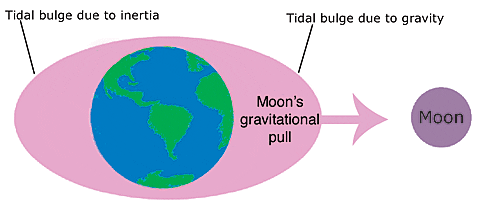TidesNearly all marine coastlines experience the rhythmic rise and fall of sea level called tides. The daily oscillation in ocean level is a product of the gravitational attraction of the Moon and Sun on Earth's oceans and varies in degree worldwide. Tidal action is an important force behind coastal erosion and deposition as the shoreline migrates landward and seaward. Causes of TidesThe gravitational attraction of the Sun is about half that of the of the Moon on the Earth. Gravitational attraction is a function of both the mass of the objects and the distance between them. Even though the Moon is much smaller in mass than the Sun it is closer and thus has a greater influence on the Earth than does the Sun. The gravitational pull of the Moon and the Sun stretches both solid and fluid surfaces of the Earth. This creates a tidal bulge in the atmosphere, the oceans and to a very slight extent the Earth's crust.
Figure 21.8 The two forces that result in tides Gravity is not the only force responsible for a tidal bulge. Inertia, the tendency of moving objects to continue moving in a straight line or stay motionless, also affects the tidal bulge. As the gravitational force draws water closer to the Moon the inertial force tries to keep it in place. The tidal bulge forms as the gravitation force exceeds the inertial force on the near side. The gravitational force of the far (opposite) side is less because it is farther away from the Moon. On this side, the inertial force exceeds the gravitational force. Here the water attempts to keep going in a straight line, moving away from the Earth, creating another, smaller bulge. Thus tidal bulge, is greatest on the side of the Earth facing the Moon or Sun ("near side") simply because it's closer than the "far side" of the Earth. |
